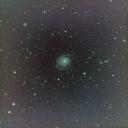Howdy, Stranger!
It looks like you're new here. If you want to get involved, click one of these buttons!
DBE can't eliminate vignette
I’m having a problem with background modelization, and can’t seem to get things right. The jpeg (stretched) straight out of integration is attached, and as you can see, there appears to be a significant vignette. I’ve tried ABE, as well as DBE, using both subtraction and division, and also placing the DBE points automatically, manually, and as an axial. All of these result in horrible splotches of color around the outer periphery that I can’t seem to get rid of.
The images (10+ hours total) were taken over three nights, and a random sample of a single image on each of the three nights shows a similar pattern when debayered. There’s no vignette that’s apparent (to me) un the un-debayered images, although that may be normal.
I’ve taken another series of flats on the assumption that my previous ones were bad, but the result is exactly the same; an obvious circular color pattern around the center of the image that I can’t seem to get rid of with DBE (or ABE). Any idea what might be causing this and/or what I could possibly do to correct it? This is the first time I’ve run into anything like this, and it’s very frustrating. After several hours of trying to fix it, I’m about ready to just do a severe crop and go from there.
The xisf file seemed to be a bit too large to upload, so it can be accessed from this Dropbox link.



Comments